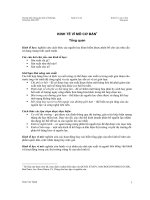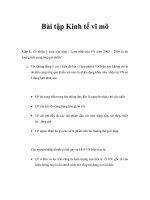- Trang chủ >>
- Đại cương >>
- Kinh tế vĩ mô
Inflation and phillips curve (KINH tế vĩ mô 1)
Bạn đang xem bản rút gọn của tài liệu. Xem và tải ngay bản đầy đủ của tài liệu tại đây (1.02 MB, 39 trang )
Chapter 9 - Inflation and Phillips curve
Content
I Overview of inflation
II Cost of inflation
III Phillips curve – relationship between inflation and unemployment
I Overview of inflation
1 Definition and computing method
Inflation is a sustained increase in the general price level of goods and services in
an economy over a period of time
Or sustained reduction in the purchasing power per unit of money – a loss of real
value in the medium of exchange and unit of account within the economy (each unit
of currency buys fewer goods and services)
Deflation is the contrary concept as a sustained decrease in the general price level
of goods and services in an economy over a period of time or sustained increase in
the purchasing power per unit of money
Other related concepts: disinflation - a decrease in the rate of inflation;
hyperinflation - an out-of-control inflationary spiral; stagflation - a combination of
inflation, slow economic growth and high unemployment; reflation - an attempt to
raise the general level of prices to counteract deflationary pressures.
I Overview of inflation
1 Definition and computing method
Other indices could be used to calculate inflation: GDP deflator, PPI (producer
price index) or core price index (core CPI)
I Overview of inflation
2 Classification
Moderate Inflation: inflation rate < 10%/year, prices increases slowly. Moderate
inflation can spur production because price increases leading to highet profit for
enterprises,therefore, firms will increases quantity.
Galloping Inflation: inflation rate is from 10% to 99% per year. This type will destroy
economy and curb engines of economy.
Hyper Inflation: is defined as inflation that exceeds 100% percent per year. Costs
such as shoe-leather and menu costs are much worse with hyperinflation– and tax
systems are grossly distorted. Eventually, when costs become too great with
hyperinflation, the money loses its role as store of value, unit of account and medium of
exchange. Bartering or using commodity money becomes prevalent. In 1920s (192212/1923) Weimar Germany, CPI increased from 1 to 10 millions
I Overview of inflation
2 Classification
Expected inflation: depends on expectation of individuals about gp in the
future. Its impacts is small but help to adjust production cost.
Unexpected inflation: derives from exogenous shocks and unexpected
factors inside economy.
I Overview of inflation
3 Causes of inflation
Demand-pull inflation is caused by continuing rises in AD in the economy.
The increase in AD may be caused by either increases in the money supply or
increases in G-expenditure when the economy is close to full employment.
In general, demand-pull inflation is
typically associated with a booming
economy.
I Overview of inflation
3 Causes of inflation
Cost-push inflation is associated with continuing rises in costs. Rises in
costs may originate from a number of different sources such as wage
increases and other higher costs of production (e.g. raw materials).
I Overview of inflation
3 Causes of inflation
Money
quantity theory – the classical theory of inflation
Velocity and the quantity equation
Quantity equation: M × V = P × Y
+ Quantity of money (M)
+ Velocity of money (V)
+ Dollar value of the economy’s output of goods and services (P × Y )
This quantity shows that: an increase in quantity of money must be reflected in:
+ Price level must rise
+ Quantity of output must rise
+ Velocity of money must fall
I Overview of inflation
3 Causes of inflation
Money quantity theory – the classical theory of inflation
Five steps - essence of quantity theory of money
1. Velocity of money: Relatively stable over time
2. Changes in quantity of money (M) will lead to Proportionate changes in nominal value of
output (P × Y)
3. Economy’s output of goods and services (Y): in long run primarily determined by factor
supplies and available production technology. Because money is neutral then Money does not
affect output in the long run
4. Change in money supply (M): Induces proportional changes in the nominal value of output
(P × Y) and Reflected in changes in the price level (P)
5. Therefore, Central bank - increases the money supply rapidly → High rate of inflation.
→ Money quantity theory explains cause of long run inflation
“Inflation is always and everywhere a monetary phenomenon.” —Milton Friedman, 1963
Nominal GDP, quantity of money, & velocity of money
This figure shows the nominal value of output as measured by nominal GDP, the quantity of money as measured by M2, and the velocity of money as measured by their
ratio. For comparability, all three series have been scaled to equal 100 in 1960. Notice that nominal GDP and the quantity of money have grown dramatically over this
period, while velocity has been relatively stable.
I Overview of inflation
4 Policies to deal with inflation
4.1.Fiscal policy comprises changes in government expenditure and/or
taxation. The aim is to affect the level of AD through a policy known as
demand management. In the case of controlling inflation, this involves
reducing government expenditure and/or increasing taxation in what is called
a deflationary fiscal policy. Such policies are likely to be effective if inflation
has been diagnosed as demand-pull since a reduction in government
expenditure or an increase in income tax will reduce aggregate demand in the
economy.
I Overview of inflation
4 Policies to deal with inflation
4.2.Monetary policy is concerned with influencing the money supply and the
interest rate. In terms of controlling inflation, the central bank can aim to
reduce the money supply thus reducing spending and, therefore, the
aggregate demand, or it can increase the interest rate so as to increase the
cost of borrowing. Both policies can be seen as deflationary monetary policy.
Since monetarists view the growth of the money supply as being the main
cause of inflation, any control of inflation from a monetarist viewpoint must
involve control of the money supply.
I Overview of inflation
4 Policies to deal with inflation
4.3.Prices and incomes policy aim to limit and, in certain cases, freeze
wage and price increases. In the past they have either been statutory or
voluntary. Statutory prices and incomes policies have to be enforced by
government legislation, such as the EU minimum wage legislation. With a
voluntary prices and incomes policy the government aims to control prices
and incomes through voluntary restraint, possibly by obtaining the support of
the unions and employers.
I Overview of inflation
4 Policies to deal with inflation
4.4. Supply-side policy is concerned with instituting measures aimed at shifting
the aggregate supply curve to the right. Supply-side economics is the use of
microeconomic incentives to alter the level of full employment and the level of
potential output in the economy. If inflation is caused by cost-push pressures,
supply-side policy can help to reduce these cost pressures in two ways:
(1) by reducing the power of trade unions and/or firms (e.g. by anti-monopoly
legislation) and thereby encouraging more competition in the supply of labour
and/or goods,
(2) by encouraging increases in productivity through the retraining of labour, or by
investment grants to firms, or by tax incentives, etc.
I Overview of inflation
4 Policies to deal with inflation
4.5.Learning to live with inflation involves accepting the fact that inflation
is here to stay when standard anti –inflationary policy measures appear
ineffective. In such a situation we just have to learn to live with inflation.
Learning to live with inflation involves the government, employers and
workers taking inflation into account in their everyday transactions. For
example, the government/employers may use indexation in wage/pensions
contracts. Indexation is when wages or pensions are increased in line with the
current rate of inflation. Indexation is aimed at nullifying the effects of
inflation.
II Cost of inflation
The inflation tax
●Revenue the government raises by creating (printing) money
●Tax on everyone who holds money
Shoe-leather costs
●Resources wasted when inflation encourages people to reduce their money
holdings
●Can be substantial
Menu costs
●Costs of changing prices
●Inflation – increases menu costs that firms must bear
II Cost of inflation
Relative-price variability & misallocation of resources
●Market economies: rely on relative prices to allocate scarce resources
●Consumers - compare
●Quality and prices of various goods and services
●Determine allocation of scarce factors of production
●Inflation - distorts relative prices
●Consumer decisions – distorted
●Markets - less able to allocate resources to their best use
II Cost of inflation
Inflation-induced tax distortions
● Taxes – distort incentives: many taxes are more problematic in the presence of inflation
(1) Tax treatment of capital gains
●Capital gains – Profits:
●Sell an asset for more than its purchase price
●Inflation discourages saving
●Exaggerates the size of capital gains
●Increases the tax burden
(2) Tax treatment of interest income
●Nominal interest earned on savings
●Treated as income
●Even though part of the nominal interest rate compensates for inflation
How inflation raises the tax burden on saving
Econo
Eco
my A
nom
(price
yB
stabili
(infl
ty)
atio
n)
Real interest rate
4%
4%
Inflation rate 0.08
0
8
Nominal interest
4
12
1
3
3
9
3
1
rate
(real interest rate
+ inflation rate)
Reduced interest due
to 25 percent tax
(.25 × nominal
interest rate)
After-tax nominal
interest rate
(.75 × nominal
interest rate)
II Cost of inflation
Confusion and inconvenience
●Money is the yardstick with which we measure economic transactions
●The central bank’s job is to Ensure the reliability of money. But when the central bank
increases the money supply, it will creates inflation and erodes the real value of the unit
of account → 1 unit of money value in year t is no longer equal to 1 unit of money value
year t +x → direct comparison is inaccurate
A special cost of unexpected inflation: arbitrary redistributions of wealth
●Inflation - volatile & uncertain when the average rate of inflation is high
●Unexpected inflation: redistributes wealth among the population Not by merit and Not by
need
●In details, unexpected inflation redistribute wealth among debtors and creditors, workers
and employers, tax payers and state









